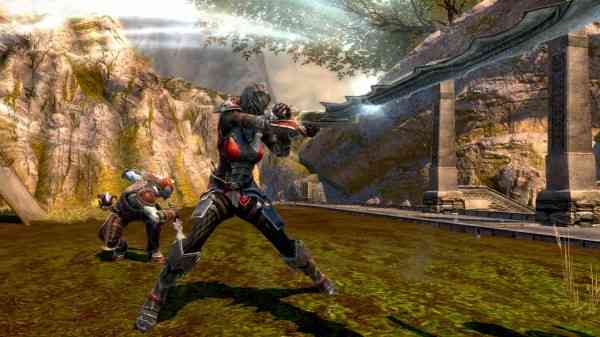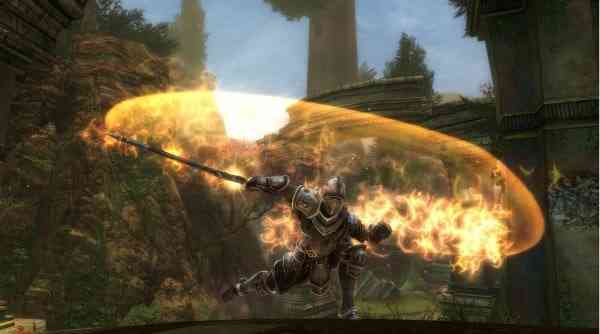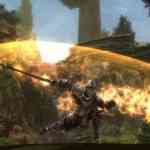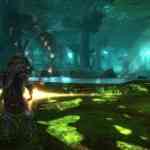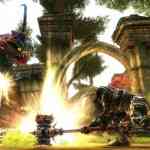I seem to have this love/hate relationship with RPG adventure games. On one hand, they appeal to the anal retentiveness and control freak part of my personality. I spend hours fine tuning items; tweaking the stats of my character; selling and resupplying items; and then comparing and contrasting the items I have for maximum efficiency and impact. My wife makes fun of how much time I spend doing these things rather than actually playing the game. I do not know what it is, but there is a sense of satisfaction in collecting and upgrading new equipment while making virtual money off the unwanted stuff. On the other hand, I tend to become addicted to these games as awhole, much like I have almost become with Kingdoms of Amalur: Reckoning on the PlayStation 3.
Kingdoms of Amalur: Reckoning starts out with a bang as you are revived from a deathly state while tangled in a pile of corpses. From here you are lead to a tutorial section where you learn to attack, defend, and use magic. You can attack with either your primary and secondary weapons and you can also attack using magic. With this in mind, attacks can come in many forms including the use of magical staves, long swords, great swords, daggers, sceptres, hammers, bow and arrows and several others. For those looking for quick escapes, you run by holding down the “X” button and the analog pad. Should you be forced into a defensive mode, you block by pressing the “L1” while the circle button allows you to dodge depending on which way you like to go. Health potions and other items can be used quickly with the D pad.
Becoming accustomed to the games controls was not an issue and you will find that moving your character is as smooth as silk. Something I noted during my time with the game is that while the Kingdom of Amalur is large and a little overwhelming, I did not get the sense of total freedom of going anywhere I wanted. For example, your character can only jump down to surfaces below and only on certain platforms. There is no jumping up or climbing up random surfaces and no falling into bodies of water without these platforms. What is even stranger is that you can jump off these specific platforms at great heights (such as a cliff) with no damage occuring to your character. He just rolls along the ground after he hits it and that is that.
Despite this, Kingdoms of Amalur: Reckoning is fun and engaging. For an RPG it is fast-paced and reminds me of games like God of War, Batman: Arkham Asylum, and Ninja Gaiden, especially when the slow-motion scenes kick in after a well-timed block with your shield. For the first part of the game I got away with merely button mashing; but as I progressed I had to change my strategy in order to minimize the damage to my health, especially as the enemies became tougher and numerous. In fact, fighting the various enemies was a real treat especially when they have different fighting styles and forms. For example, the trolls are large, powerful and a little intimidating, but if you get out of the way from their swings, they are not too difficult to take down. When surrounded by several enemies, Kingdoms of Amalur: Reckoning forces you to use various tactics in order to take down the enemies. The variety in combat was something I certainly enjoyed in the game.
The enemy AI is reasonably smart. Enemies do not always react in a predictable manner and I found them to be quite a challenge at times. Again, I would have to employ a variety of different combat tactics in order to proceed. For instance, I found charging my weapons by holding down the attack button worked well against tougher opponents while button mashing and blocking worked with everyone else. A minor annoying aspect of the game was when you used ranged attacks on the enemy, it automatically locks on to a target for you and does not appear to let you toggle between targets. This is frustrating as the game does not always correctly pick the closest enemy to you. Also, you have a limited number of arrows before you run out and having to wait a few seconds in order to replenish can be a burden. Otherwise, combining ranged and melee attacks is a fun experience and one that I used over and over again.
After you defeat the bad guys, your experience increases which causes you to level up, which is typical RPG gaming. You can then select various combat styles using a skill tree which is divided between might, finesse, and sorcery. The “Might” skill tree emphasizes the use of swords and hammers while the “Finesse” tree emphasizes dagger and precision weapons and stealth moves. The “Sorcery” skill tree emphasizes magical weapons like staves and sceptres. The cool feature of Kingdoms of Amalur: Reckoning is that unlike some other games, you are not locked in to one particular style where other skill paths are closed. Here you can have multiple skills across a variety of specialities. For example, you can have a mage style character who uses both magic and daggers – weapons which are normally used by assassins for stealth style attacks. Levelling up also enables you to choose skills in blacksmithing, alchemy, thievery, stealth, and persuasion, all of which can be used to your advantage and adds further customization. Also, depending on your level of blacksmithing, crafting, or skill in alchemy, you can create your own items at forges that are available in towns.
Needless to say, the level of customization in Kingdoms of Amalur: Reckoning is very wide and probably one of the more in-depth features of the game. There are likely dozens and dozens of different grades and types of just one style of weapon, and combined with your own crafted weapons imbued with magic or gems, the combinations are endless.
While not as vast as the number of items in the game, there are many side quests in addition to the lengthy main quest in Kingdoms of Amalur: Reckoning. In fact, it almost seems like every NPC in the game wants you to do something for them. It almost made me feel somewhat detached from my own character and in the end the requests did become monotonous. At the end of the day the side quests just help you gain experience points, obtain some gold and possibly some good loot. While a little annoying on the number of requests from NPCs, you know which ones have something to ask of you as they often have a huge bright exclamation point above their head signalling you to talk to them. Nevertheless, I wished they did not have as many as these requests or made them less obvious.
Getting around Amalur is not incredibly difficult after you have travelled everywhere. In other words, if you have travelled the map to certain areas or towns, you are able to fast track to that area without walking all the way there. While there is also a small map on the game screen that signifies your location and where you are supposed to go next, I constantly referred to the static large screen map as orientation was occasionally difficult, especially when your destination was quite far away.
Graphically, Kingdoms of Amalur: Reckoning is impressive. The environments in the outside world are lush, colourful and just plain pretty. It really provides a fantasy world experience, and while not as detailed as compared to other games like Tekken or Final Fantasy (especially in the cut-scenes), seeing your character in slow-motion combat as they are swinging a blazing staff with fiery trailers behind it really made me think, “That looks pretty cool.” Water effects show some good reflections and lighting is well implemented, but I did not come across changes in weather such as rain or falling snow.
The music in the game is also very solid and invokes a sense of adventure and excitement. Couple this with some great sound effects, from the environment around you the the weapons used in battle, Kingdoms of Amalur: Reckoning is a game that delivers in the sound department.
A negative drawback to Kingdoms of Amalur: Reckoning is the lack of multiplayer capabilities. While there is some downloadable online content using an online pass code, players do not get to go on adventures together which really would have pushed this game to another level, especially if it was a MMORPG style game. Another area where it could have benefited is by having more complex choices or illustrating that not everything is black and white. It seems like everything was solved using violence and no real alternative to use other skills is offered. And while I understand the rating is “Mature,” the game could have easily been modified to “Teen” by taking away some of the blood as it did not add much to the game.
Being a fan of RPG games, I found myself somewhat emotionally unattached to the games plotline or characters. Perhaps it is because I have played so many of them over the years but I just did not have any emotional response to the story, the side requests, or to the sense of being part of a team. After all, your “comrades” are not that likeable and are not with you most of the time. The NPC’s either want your money or just want you to do something for them; and there is no loved one to save or an obvious greater good to serve. It just seems like you are just travelling along with no real sense of purpose. Heck, there isn’t even a trusty sidekick or any real sense of building “relationships” with others which can find in are found in some of the best RPGs and fantasy games in the market.
Overall, Kingdoms of Amalur: Reckoning is a visually stunning and enjoyable game to play when it comes to its combat and sense of adventure. The gameplay and customization is deep and players can literally spend hundreds of hours playing this game. Nevertheless, while deep in the technical sense, Kingdoms of Amalur: Reckoning seems to lack some of the human complexities found in other RPG adventure games. Yet despite the lack of emotional connection with the story and characters it is game that is solid on many levels and will likely satisfy those looking for an RPG fix from EA before Mass Effect 3 arrives later this Spring.
